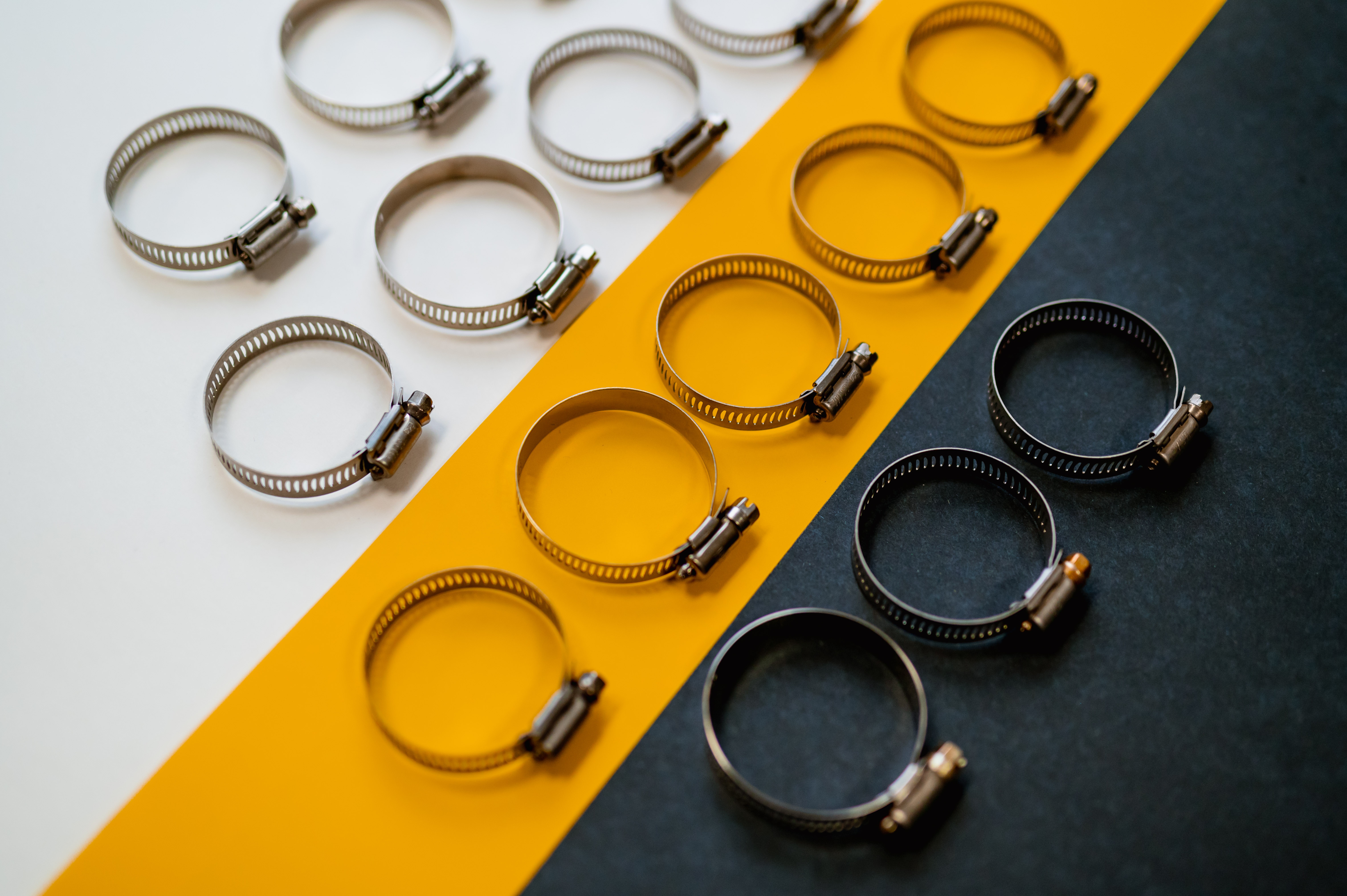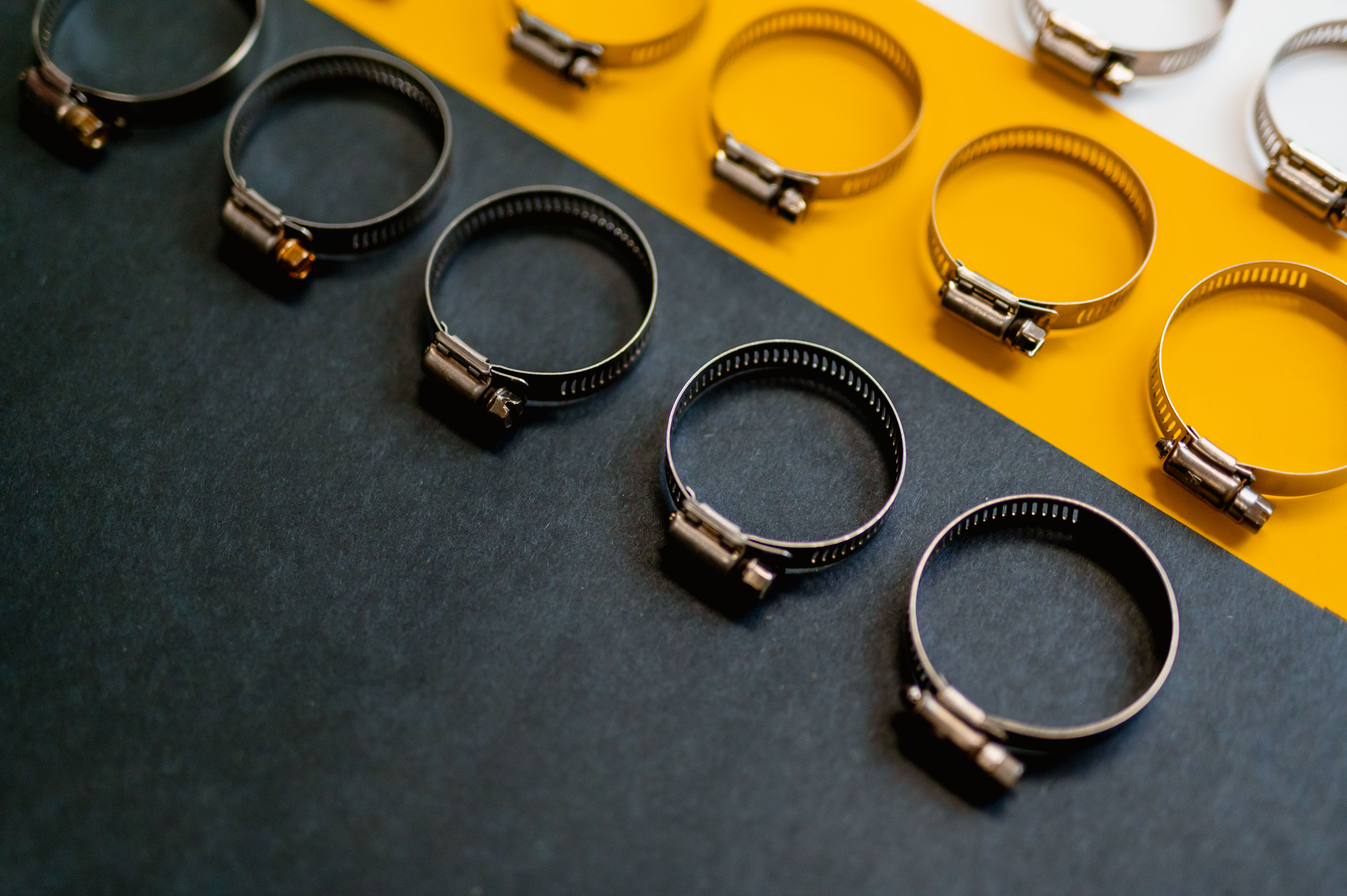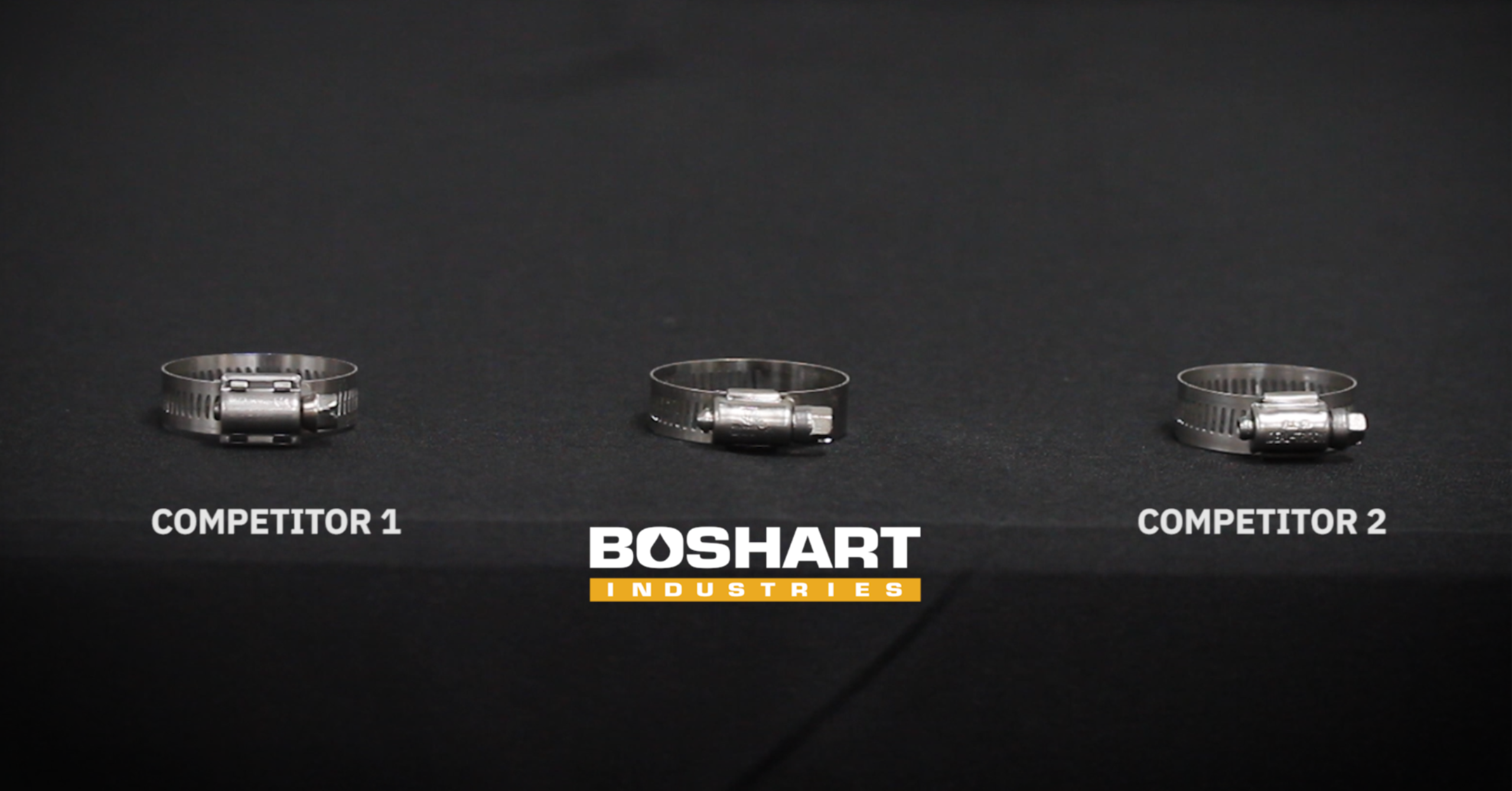Gear Clamps are a very simple product. They are used to secure pipe onto different types of fittings or connections. Even though Gear Clamps are such a simple product, there are many misconceptions in the market. In this Webinar, we highlight some of these, as well as, go over some key features to look out for.
Transcript
Hello and welcome everybody to our webinar on gear clamps. We’re glad you decided to join us.
My name is Will Bender. I am the Quality Assurance Analyst here at Boshart Industries & backing me up, I have Paul Erb, who is the Research & Development Manager.
Feel free during the presentation to type out any questions that you have. We will do our best to answer all questions after the presentation.
If you want to type out a question, you should see a side bar on the right hand side of your screen.
If you click on the top button, which looks like an arrow in a box, it will open up a little menu with a question box which you can type your questions and we will be able to see them.
Please note the slide number if you’re referencing a specific slide. The numbers will be displayed on the bottom right of the slide.
Stay connected with us by following Boshart Industries on Instagram, Linked in, and Facebook.
Introduction
Clamps are pretty easy to understand how they work and easy to use. But, we chose to do a webinar on clamps not just to explain function, but because there’s a lot of published information on clamps that isn’t exactly true.
In this webinar, I will go over what gear clamps are, where they’re used, some features and benefits of our clamps, the quality assurance performed here at Boshart’s, and common misconceptions and myths about clamps.
What are Gear Clamps?
I am going to explain what a gear clamp is and how it works as a refresher for those of you who already know and for those who would like to learn.
It’s important to note that worm gear clamps are also known as just gear clamps, worm drive clamps, and hose clamps.
They consist of a 3 piece housing, like our 2-SSC series, or a 4 pieces housing like the Breeze clamps. The housing and the screw work together to open and close the clamp band. The components are the band, a housing which can also have a saddle piece, and a screw.
The housing, which holds the screw, is fastened on the band. When the screw is turned, the threads of the screw mate with the slots of the band. This pulls or pushes the band to close or open.
Gear clamps can fasten pipe, secure hoses, and be used wherever a strong band is needed. This is done by tightening, or clamping, one item over the other.
The applications are not limited to certain industries although there are industries that use them often.
Applications
As I had said before, there are industries that use them more. Plumbers use them to fasten rubber couplings to pipe and for clamping plastic piping, like poly pipe, over barbed fittings.
As well as fastening, the compression caused by the clamp also creates a true seal in those applications.
In the automotive industry, the clamps are used to secure any type of hose or line. Rubber couplings are also used in this industry.
Clamps are also used in the water well industry by well installers for the use of torque arrestors.
They are also used to hold dry vents and air duct work for HVAC.
I will now go over Boshart’s clamps and the features that they offer.
Boshart Clamp's Features & Benefits
We carry two lines of clamps. One are the SSC line from Breeze that are a United States manufactured clamp. Some applications require that the clamps are from the United States and we can offer clamps to appease that requirement.
The second line are our 2-SSC line. These are the Boshart clamps and they can be used from standard applications to the toughest worm gear clamp applications.
Torque testing is important because it shows how much force can be applied to the band by tightening the screw before it strips or breaks.
The SAE J1508 standard used for gear clamps requires clamps to achieve 50 in/lbs before breaking.
On the Boshart 2-SSC clamp lines, our in house torque testing results consistently above 120 in/lbs before breaking.
As a frame of reference, an average torque that someone could apply with a standard nut driver is roughly 40 to 45 inch pounds. These are often installed with power tools or other types of socket wrenches capable of much more than that.
The housings of the 2-SSC series use a 3 piece interlocked system to attach to the band. You can see that the housing actually wraps around the band.
The 3 piece design has the tabs of the housing curl under the band. This ensures that when the clamp is tightened, the housing tabs get held between the pipe and the band. So the tighter the clamp, the tighter the housing is being held to the band.
We believe that the 3 piece interlocking system can get a higher torque rating because of this feature. I will explain why we believe that the 4 piece interlocking system gets less torque.
The 4 piece interlocking design housing is made up of 2 pieces: the housing and the saddle. The saddle sits under the band and holds the housing using 4 tabs.
As I had said before, and this is only our belief, the 4 piece design can’t achieve as high of a torque rating because the pressure from tightening the clamp is transferred onto the 4 tabs. As the clamp is tightened, the pressure on the tabs makes them want to open up or bend out.
If this happens, the housing will push away as far as it can from the band. This means that the screw will lose some engagement with the band slots. This increases the chance of the unit stripping and why we think the maximum torque is lower than that of a 3 piece interlocking system.
Clamp Series
There are 3 clamp series: the 87 series, the 67 series, and the 77 series and I’ll go over each in turn.
The 87 series are our most corrosive resistant clamps. Each component is made of 300 grade stainless steel. The high chromium content of the 300 grade stainless steel makes for the best corrosion resistance out of any clamp.
Because of the high corrosion resistance, these clamps are marine grade; meaning that they can be used in any application but absolutely should be used in wells or buried applications that may be exposed to corrosive elements with no shielding.
The 67 series are made entirely of 200 grade stainless steel. This has less nickel than the 87 series and so there is slightly less corrosion resistance.
Once installed, these clamps should be easily accessible. This means that they should not be used in buried or in well applications but they will serve well in most other plumbing applications.
The 77 series clamps use 200 grade stainless steel for the band and the housing and the screw is made from a yellow dichromate plated carbon steel. The colour of the screw makes it easy to identify that it is a 77 series clamp.
Stainless Steel Information
They are the cheapest option and can be used in standard applications where corrosion will not be an issue such as dryer and duct work.
In stainless steel, chromium oxidizes on the surface to from a self repairing chromium oxide layer.
This layer is electrochemically passive which just means that it is resistant to oxidation and corrosion. In order for the layer to form, there must be a minimum of 10.5% of chromium in the overall composition.
The more chromium that is added to the composition, the more corrosion resistant it will become. 300 grade stainless steels have over 18% chromium or more with the exception of 316 stainless which has 16-18% but has added molybdenum which makes it even more corrosion resistant and suitable for use in severe environments.
Nickel also increases the corrosion resistance in stainless steels. Most importantly though, it is responsible for forming austenite, which is why stainless steels containing nickel are called austenitic. This creates high strength at high and low temperatures.
300 grade stainless steels typically have a minimum of 8% nickel.
Packaging
The clamps can be ordered in 3 different packaging types.
The standard option would be bag quantities. The master cartons are boxed but the products are bagged in quantities of 10 or in bags of 5; typically for the larger sized clamps. The bags used for the 2-SSC series are zip locked whereas the SSC are not.
Another option is to order the clamps in bulk. The clamps will come in a master carton with no other individual packaging.
The last option is to order the clamps in small quantity boxes.
Now I am going to talk about information on clamps that often surfaces which is not altogether correct.
I am going to explain why these myths are untrue.
Misconceptions about Clamps
The first bit of information that needs to be wholly explained is stainless steel magnetism. The misconception is that austenitic grades of stainless steel, such as 300 grades, are non magnetic. And if they are magnetic, that they are poor quality or they have less corrosion resistance.
This myth stems from the fact that the raw alloys used in these steels are actually non magnetic in nature.
However, when the material is cold worked, bent, deep drawn, and formed into tube or pipe it can acquire magnetism.
The rise in magnetism is not actually a bad thing. Increased magnetism is directly related to an increase in tensile strength.
In addition, magnetism does not change the molecular structure of the material so it does not have any effect on the corrosion resistance.
Corrosion resistance is entirely dependent on the percentage of chromium and nickel in the alloy.
The magnet test was used as a method of checking the quality of stainless steel but it should be disregarded.
There are other grades of stainless steel that are also nonmagnetic or only slightly magnetized. The magnet test can have some using a grade of stainless steel that will not work for their application.
As an example, 200 grade stainless steels can be nonmagnetic. They have a lower percentage of nickel than 300 grades do and therefor have less corrosion resistance.
Indian companies in the 1980’s were fooling customers who were using the magnet test. Since 200 grade stainless steel is cheaper than 300 grades, they used 200 grade stainless steel cookware and passed it off as 300 grade stainless steels.
The only way to be sure of the material is by having it analyzed.
There is some discrepancy between whether or not a clamp with a 9/16 band will create more sealing force than a 1/2” band. I will tell you now that a 1/2” band does in fact create more sealing force. The math to support this is displayed, but I’m just going to tell you the results.
On a 1” piece of poly pipe and tightening the screw 60 inch pounds, the 9/16 band’s total sealing force is 82.19 pounds per square inch.
On the same application, the 1/2” band’s total sealing force is 91.6 pounds per square inch.
That is almost 11 and a half percent more sealing force than the 9/16 band.
It is the same principal of standing on one nail versus standing on a bed of nails. When there is a smaller surface area, the applied force is concentrated to that smaller surface.
Another misconception about the 9/16 bands is that they are physically stronger than the ½” bands.
At the thinnest point of the band, the 1/2” bands actually have 15.5% more material providing increased tensile strength. The increased band width does not add structural strength.
An in house tensile strength test was performed on the 1/2” band versus the 9/16” band.
On an average, the 1/2” band broke at 1446 pounds and the 9/16 band broke at an average of 991 pounds. That is a difference of 46%.
This bands always broke at the thinnest point of the band.
With the myths in mind, Boshart’s has extensive inspections for clamps.
QA Department
Bosharts tests the material of our clamps by using an XRF Alloy Analyzer. The XRF uses x-rays to analyze the material composition.
The test is non destructive so the part is not damaged in any way.
We can perform material comparatives and material identification upon request.
Free turning torque is how much force is needed to turn the clamp screws. This is important because often installers will use power tools to turn the screws. A low free turning torque ensures that the clamp is far less likely to strip or fall off the banding.
Bosharts uses an electric torque drill to test the free turning torque of the screws. The drill is set to a very low torque setting of 3 inch pounds.
With the help from our research and development team, we created gauges that help us test to the largest and smallest sizes that the band will allow.
The gauges are sized to the meet and in some cases, exceed the SAE J1508 standard.
The 2-SSC series clamps are certified by UPC to the SAE J1508 standard but we have requested that the clamps be tested to a higher torque. We can have the UPC shield stamped on our product because of this certification.
Other clamps may also be certified with UPC but not all are tested to a higher torque rating.
Regardless of the UPC certification, we carry our own expectations for our clamps. For the 2-SSC series, we don’t allow the clamps to break at a torque lower than 75 inch pounds.
Using a torque wrench, we tighten a clamp over a piece of poly pipe over a barbed fitting until the clamp strips or breaks. We consistently see the clamps break over 120 inch pounds which is 2 times more than the UPC certification.
Here at Boshart’s, we carry many additional products that can be used with gear clamps.
Additional Products Boshart Offers
As a few examples, Boshart’s carries Torque Arrestors, Insert fittings, and Flexible Rubber Couplings that all use clamps in order to fasten and/or seal.
We also carry flexible nut drivers and contractor bins for easy storage of your clamps.
Conclusion
That is the end of the presentation today. You can learn more about the features we offer at Boshart’s as well as other useful information on plumbing and water well products.
At BoshartU, our goal is to equip you and your team with the knowledge you need to be more successful.
We regularly publish new blogs and content that will help you become more comfortable and confident with our products.
Have further questions about this subject?

Head over to Boshart's Knowledge Base: technical product information, guidelines, and more.





SHARE